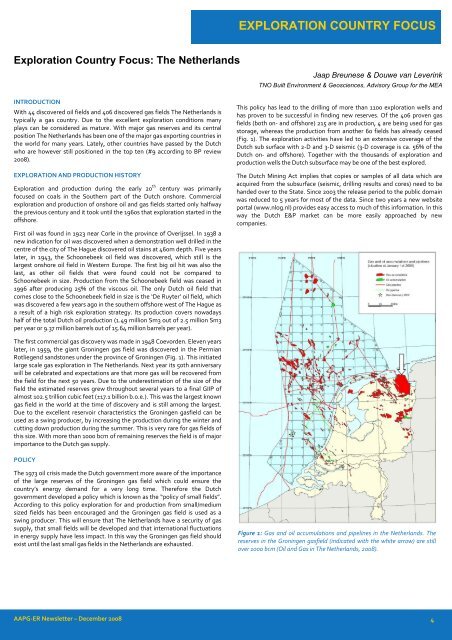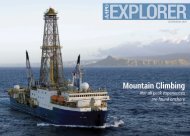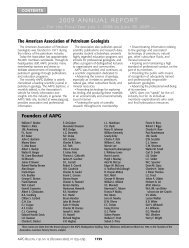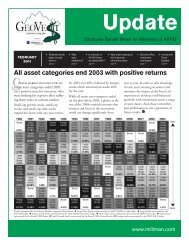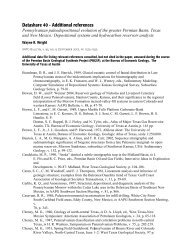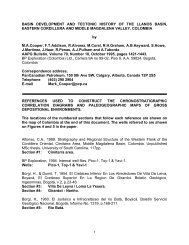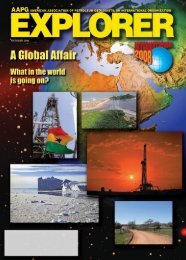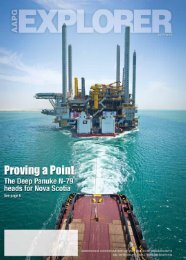president's message - American Association of Petroleum Geologists
president's message - American Association of Petroleum Geologists
president's message - American Association of Petroleum Geologists
Create successful ePaper yourself
Turn your PDF publications into a flip-book with our unique Google optimized e-Paper software.
Exploration Country Focus: The Netherlands<br />
INTRODUCTION<br />
With 44 discovered oil fields and 406 discovered gas fields The Netherlands is<br />
typically a gas country. Due to the excellent exploration conditions many<br />
plays can be considered as mature. With major gas reserves and its central<br />
position The Netherlands has been one <strong>of</strong> the major gas exporting countries in<br />
the world for many years. Lately, other countries have passed by the Dutch<br />
who are however still positioned in the top ten (#9 according to BP review<br />
2008).<br />
EXPLORATION AND PRODUCTION HISTORY<br />
Exploration and production during the early 20 th century was primarily<br />
focused on coals in the Southern part <strong>of</strong> the Dutch onshore. Commercial<br />
exploration and production <strong>of</strong> onshore oil and gas fields started only halfway<br />
the previous century and it took until the 1960s that exploration started in the<br />
<strong>of</strong>fshore.<br />
First oil was found in 1923 near Corle in the province <strong>of</strong> Overijssel. In 1938 a<br />
new indication for oil was discovered when a demonstration well drilled in the<br />
centre <strong>of</strong> the city <strong>of</strong> The Hague discovered oil stains at 460m depth. Five years<br />
later, in 1943, the Schoonebeek oil field was discovered, which still is the<br />
largest onshore oil field in Western Europe. The first big oil hit was also the<br />
last, as other oil fields that were found could not be compared to<br />
Schoonebeek in size. Production from the Schoonebeek field was ceased in<br />
1996 after producing 25% <strong>of</strong> the viscous oil. The only Dutch oil field that<br />
comes close to the Schoonebeek field in size is the ‘De Ruyter’ oil field, which<br />
was discovered a few years ago in the southern <strong>of</strong>fshore west <strong>of</strong> The Hague as<br />
a result <strong>of</strong> a high risk exploration strategy. Its production covers nowadays<br />
half <strong>of</strong> the total Dutch oil production (1.49 million Sm3 out <strong>of</strong> 2.5 million Sm3<br />
per year or 9.37 million barrels out <strong>of</strong> 15.64 million barrels per year).<br />
The first commercial gas discovery was made in 1948 Coevorden. Eleven years<br />
later, in 1959, the giant Groningen gas field was discovered in the Permian<br />
Rotliegend sandstones under the province <strong>of</strong> Groningen (Fig. 1). This initiated<br />
large scale gas exploration in The Netherlands. Next year its 50th anniversary<br />
will be celebrated and expectations are that more gas will be recovered from<br />
the field for the next 50 years. Due to the underestimation <strong>of</strong> the size <strong>of</strong> the<br />
field the estimated reserves grew throughout several years to a final GIIP <strong>of</strong><br />
almost 102.5 trillion cubic feet (±17.1 billion b.o.e.). This was the largest known<br />
gas field in the world at the time <strong>of</strong> discovery and is still among the largest.<br />
Due to the excellent reservoir characteristics the Groningen gasfield can be<br />
used as a swing producer, by increasing the production during the winter and<br />
cutting down production during the summer. This is very rare for gas fields <strong>of</strong><br />
this size. With more than 1000 bcm <strong>of</strong> remaining reserves the field is <strong>of</strong> major<br />
importance to the Dutch gas supply.<br />
POLICY<br />
The 1973 oil crisis made the Dutch government more aware <strong>of</strong> the importance<br />
<strong>of</strong> the large reserves <strong>of</strong> the Groningen gas field which could ensure the<br />
country’s energy demand for a very long time. Therefore the Dutch<br />
government developed a policy which is known as the “policy <strong>of</strong> small fields”.<br />
According to this policy exploration for and production from small/medium<br />
sized fields has been encouraged and the Groningen gas field is used as a<br />
swing producer. This will ensure that The Netherlands have a security <strong>of</strong> gas<br />
supply, that small fields will be developed and that international fluctuations<br />
in energy supply have less impact. In this way the Groningen gas field should<br />
exist until the last small gas fields in the Netherlands are exhausted.<br />
EXPLORATION COUNTRY FOCUS<br />
Jaap Breunese & Douwe van Leverink<br />
TNO Built Environment & Geosciences, Advisory Group for the MEA<br />
This policy has lead to the drilling <strong>of</strong> more than 1100 exploration wells and<br />
has proven to be successful in finding new reserves. Of the 406 proven gas<br />
fields (both on‐ and <strong>of</strong>fshore) 215 are in production, 4 are being used for gas<br />
storage, whereas the production from another 60 fields has already ceased<br />
(Fig. 1). The exploration activities have led to an extensive coverage <strong>of</strong> the<br />
Dutch sub surface with 2‐D and 3‐D seismic (3‐D coverage is ca. 56% <strong>of</strong> the<br />
Dutch on‐ and <strong>of</strong>fshore). Together with the thousands <strong>of</strong> exploration and<br />
production wells the Dutch subsurface may be one <strong>of</strong> the best explored.<br />
The Dutch Mining Act implies that copies or samples <strong>of</strong> all data which are<br />
acquired from the subsurface (seismic, drilling results and cores) need to be<br />
handed over to the State. Since 2003 the release period to the public domain<br />
was reduced to 5 years for most <strong>of</strong> the data. Since two years a new website<br />
portal (www.nlog.nl) provides easy access to much <strong>of</strong> this information. In this<br />
way the Dutch E&P market can be more easily approached by new<br />
companies.<br />
Figure 1: Gas and oil accumulations and pipelines in the Netherlands. The<br />
reserves in the Groningen gasfield (indicated with the white arrow) are still<br />
over 1000 bcm (Oil and Gas in The Netherlands, 2008).<br />
AAPG‐ER Newsletter – December 2008 4


